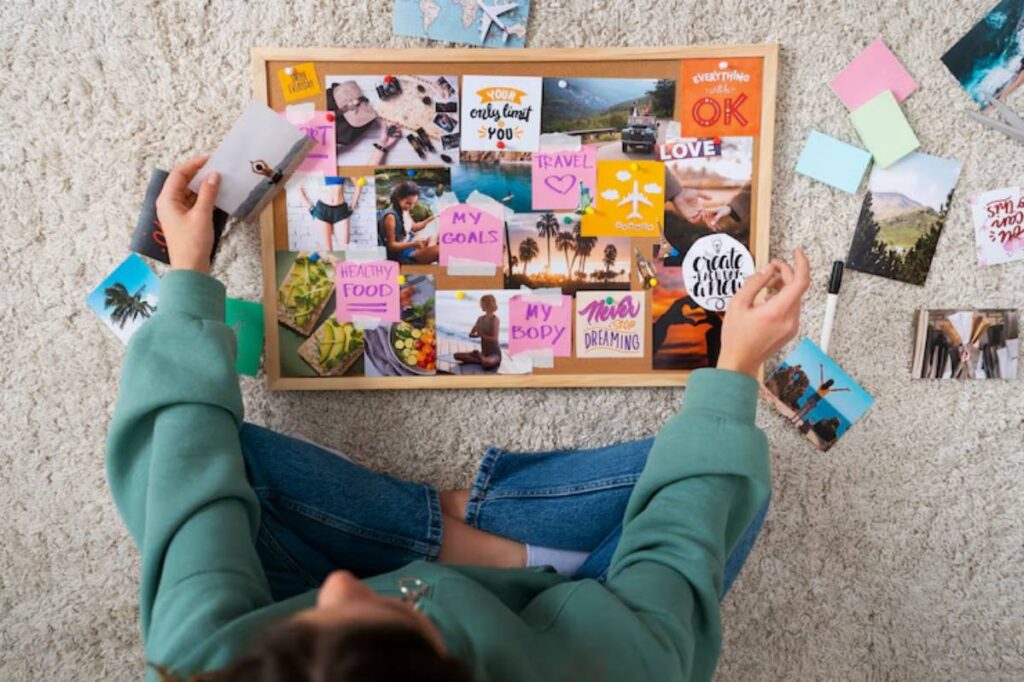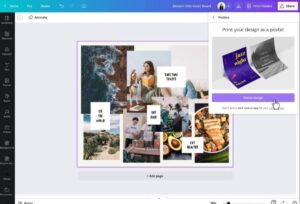The Personal Development Blog

Designing Career-Focused Vision Boards
There’s something magnetic about seeing a version of your future laid out in front of you—not as a spreadsheet, not as a list of resolutions, but as a collection of images, colors, and affirmations that somehow capture what words can’t. And when it comes to career vision boards, that visual language can be the secret sauce behind work clarity, confidence, and long-term momentum.
Let’s be real—career goals often get trapped in the realm of logic. Promotions, paychecks, LinkedIn titles. But success is more than that, isn’t it? It’s about impact, freedom, creative expression, feeling seen, and becoming who you know you’re capable of being.
That’s why this guide exists. It’s here to help you step beyond task lists and into something deeper: the space where professional goal imagery meets purpose. Where you use visuals not just to manifest what you want, but to remember who you’re becoming.
Why Create a Career Vision Board?
You might be wondering, “Can gluing a few pictures to a board really help me land my dream job or pivot careers?”
Short answer? Yes—when it’s done intentionally.
Here’s why:
- Visualisation trains the brain. Neuroscience shows that mentally rehearsing an experience (like success at work) activates the same neural pathways as doing the thing itself.
- Imagery strengthens focus. Having a visual representation of your goals keeps them top-of-mind—even when your to-do list takes over.
- Emotion drives action. Seeing yourself “winning” at work daily builds belief. And belief fuels effort.
A career vision board doesn’t just represent the job. It represents the journey.
Start With Clarity: Define What Success Looks Like to You
Before choosing images or arranging layouts, start here: What do you actually want?
Not just a promotion. But what does that promotion mean?
Not just “freelance life.” But what kind of freedom, impact, energy?
Jot down answers to these prompts:
- What would a wildly fulfilling workday look like?
- What are you doing more of—and what are you saying no to?
- Who are you surrounded by? What kind of work culture energizes you?
- What does success feel like in your body?
Let this emotional foundation guide your visual choices. Because the best boards don’t reflect titles. They reflect identity.
Career Areas You Might Map on the Board
To organize your ideas, break your board into subcategories of your professional life. Here are a few you might include:
Work Environment
Do you dream of working from a beachside café or leading meetings in a glass-walled office? Choose visuals that reflect the physical and emotional vibe of your workspace.
Role & Responsibilities
Think: What do you actually do in this dream job? Public speaking? Deep focus time? Team collaboration? Let imagery tell the story of your day-to-day.
Recognition & Achievement
Maybe it’s awards, press features, hitting revenue goals, or being seen as an expert. Represent your version of “success signals.”
Personal Branding
This is especially important if you’re in entrepreneurship or building online. Your board can reflect aesthetics, messaging, and digital presence.
Financial Goals
From your ideal salary to saving goals or a profitable side hustle, include visuals of abundance—whatever that looks like for you.
Growth & Learning
Books, degrees, certificates, or inspirational mentors—these images show how you evolve professionally.
Need to identify which professional dreams belong on your board? Check out Breaking Down Life Areas for Vision Board Planning.
Choosing Professional Goal Imagery That Resonates
Here’s where it gets fun. And meaningful.
When selecting images, go for feeling over literal meaning.
For example:
- Instead of a generic “CEO at desk” pic, choose an image that feels like leadership to you.
- Instead of a dollar sign, find a visual that evokes your why behind wealth—like a cozy home office, family travel photo, or donation receipt.
Sources for imagery:

- Canva
- Magazines
- Your own photo collection
Make sure your images reflect you. Diverse boards that represent your identity, values, and lifestyle create stronger connection and belief.
Power Words and Phrases to Anchor Your Board
Words give structure to your dreams. And in the realm of work success visualisation, they can act like mini-mantras for your board.
Here are examples to consider placing:
- “Impact Over Income”
- “Confident. Capable. Creative.”
- “This or something better”
- “I create value and get paid for it”
- “Aligned, not overwhelmed”
Choose 3–5 words or phrases that instantly connect. Keep them short and emotionally charged.
You can place these in the center, in each category, or as borders.
Layout Styles for a Career Vision Board
How you arrange your board affects how you interact with it. Here are three proven formats:
The Grid
Divide the board into 4–6 categories. Keep each area focused. Great for planners and multi-passionates.
Bullseye Style
Put your biggest goal in the middle and orbit it with supporting goals. This reinforces focus.
Timeline or Ladder
If you’re building toward one major milestone, use a left-to-right layout to show growth steps visually.
Making Your Vision Board Actionable
Vision without motion is just a screensaver. So after creating your board, keep it alive.
Place It Where You’ll See It
By your desk, in your journal, as a phone lock screen—somewhere it becomes part of your daily field of vision.
Use It in Goal Reviews
Check in monthly. Are your actions aligning? Do any images need an upgrade?
Pair It With Visualisation
Spend a few minutes each morning feeling into your future. Imagine conversations, decisions, celebrations. Make it real.
Journal Beside It

Weekly reflections like “What did I do this week that moved me toward my vision?” deepen the connection.
Common Mistakes (And How to Avoid Them)
Even with the best intentions, some boards fall flat. Here’s how to keep yours strong.
It’s Too Vague
A picture of “a laptop” doesn’t tell your brain what to focus on. Be specific: what are you doing on that laptop? Coaching? Writing a novel? Building an agency?
It Reflects Someone Else’s Dream
If it looks good but doesn’t feel aligned, it’s noise. Filter out shoulds. Choose what moves you.
It’s Crowded and Confusing
White space is your friend. A cluttered board creates cognitive overload.
It’s Left to Collect Dust
Revisit it. Evolve it. Let it be part of your growth—not a one-time project.
Digital or Physical: What Works Better for Career Boards?
Both work—but they serve different types of energy.
Digital Boards
- Easy to update
- Great for adding branding elements
- Ideal for tech-forward thinkers
Physical Boards
- Offer tactile engagement
- Easier to display in workspaces
- Great for ritual-based creators
You can also blend both. A printed digital board framed by your desk, or a physical board photographed for your phone screen.
Build a Career Vision You Can See, Feel, and Step Into
There’s something sacred about deciding that your work matters. That your gifts deserve space. That your vision isn’t too big—it’s just big enough to stretch you.
A career vision board isn’t just about what job you want next. It’s about who you’re becoming through your work.
So choose images that light you up. Words that remind you who you are. Layouts that help you stay focused. And rituals that make the whole process feel personal.
For more structured visual formats, explore Best Vision Board Layouts for Maximum Clarity.









